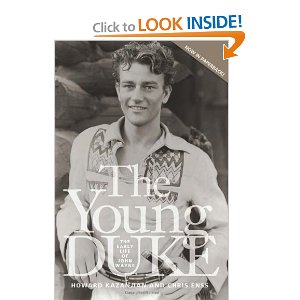Several years ago I was given the opportunity to do an interview with a production company that provided the ‘extras’ on the DVD release of The Big Trail. The book I had written about John Wayne entitled The Young Duke had been released a few months prior to the DVD hitting the market and that’s what led to the opportunity to speak about Wayne and The Big Trail. In 1930, Raoul Walsh was preparing his wagon train epic, The Big Trail. In the lead roles of scout Breck Coleman, Walsh cast 23-year-old unknown prop man and bit-part player, Duke Morrison, after Tom Mix and Gary Cooper had turned it down (Cooper starred as scout Clint Belmet in Paramount’s almost identical Fighting Caravans the following year). The Big Trail tells the story of a wagon train of pioneers who trekked from the banks of ‘The Big River’ – the Mississippi – to the Promised Land of Oregon, 2,500 miles away, and details their surmounting of hazards en route. Scout Breck is also looking to exact ‘frontier justice’ on the killers of his best friend – the train’s bullwhacker Red Flack and his sidekick Lopez are the culprits. Flack is a memorable characterization by Tyrone Power Snr., a snaggled-toothed, bullwhipping monster with a face like a bear trap. The making of The Big Trail was chaotic, with filming taking place across Arizona, California, Utah, Wyoming and Montana. For part of the shoot, Morrison had dysentery. Marguerite Churchill, his beautiful leading lady, remained only intermittently beautiful between bouts of chronic acne; and most of the cast got drunk. The logistics for such an epic $2 million production involved coordinating hundreds of extras and props, including dozens of heavy, ox-drawn Conestoga ‘prairie schooners’ (so called because of their boat-shaped hulls). In one scene the wagons descended sheer cliffs on primitive pulleys (filmed at Hurricane Bluffs, Zion National Park); in another, they ford a swollen, muddy, storm-lashed river. The film was shot in two different formats – 35 mm and 70 mm widescreen “Grandeur”. The 70 mm print of The Big Trail was exhibited at 158 minutes in only two cinemas in Hollywood and New York, while everywhere else showed the 125-minute version in 35 mm. Unfortunately, The Big Trail was a big flop. Wayne was soon dropped by Fox and the action from the film was sold to Republic, where many a B-movie hero subsequently fell under stock footage Indian attack. Viewed today, with its impressive sweep and scope, The Big Trail remains one of the great early westerns. For more information about The Young Duke visit www.chrisenss.com. 
Follow Me
© 2025 Chris Enss | Privacy Policy | Design by Winter Street Design Group | Login

